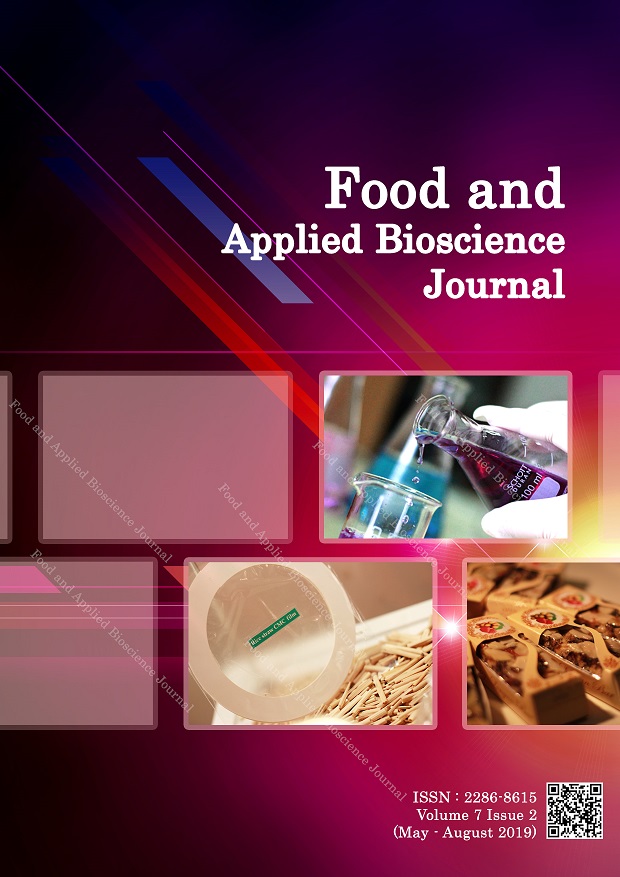Efficacy of ozone application Efficacy of ozone application and disinfection treatments on pathogens in fresh-cut vegetables
Keywords:
Ozone; Normal saline; Acetic acid; Sodium bicarbonate; potassium permanganateAbstract
Consumers and regulators are concerned about the safety of fruits, vegetables, salad, and other ready to eat (RTE) products. This includes preventing contamination from both pathogens and chemical contaminants. Novel industrial applications and improvements in ozone technology together with new regulatory actions. Ozone does not leave any residues on the treated produce and it is also accepted by many organic grower organizations. The purpose of this research was to investigate the disinfection efficacy of ozone (O(3)), normal saline, acetic acid, sodium bicarbonate, and potassium permanganate for reducing pathogen of fresh-cut kale, cantonese, cauliflower, red chili, and yard long bean. Furthermore, the decontamination efficacy and the effect of these technologies on physicochemical quality of vegetable samples were analyzed. Vegetable quality throughout the storage period (12 days) was determined to employ color and microbiological indexes, such as Salmonella spp. and Escherichia coli. O(3) was effective disinfection treatments on vegetable wash water, with a maximum microbial reduction of 1.0 log CFU mL(-1) after 15 min of 2 ppm. of ozone treatment. The advantages of this method are the use of much lower sanitizer doses and reduce the frequency of changing the water in the washing step at the packing house.
References
1. Abadias, M.; Usall, J.; Anguera, M.; Solsona, C.; Vinas, I. Microbiological quality of fresh, minimally-processed fruit and vegetables, and sprouts from retail establishments. Int. J. Food Microbiol. 2008, 123, 121–129.
2. Estrada-Garcia, T. ; Lopez-Saucedo C; Zamarripa-Ayala B; Prevalence of Escherichia coli and Salmonella spp. in street-vended food of open markets (tianguis) and general hygienic and trading practices in Mexico City. Epidemiol Infect 2004, 132(6):1181–1184.
3. Graham, D.M. ; Use of Ozone for Food Processing. Food Technology, 1997, 51(6), 72-75.
4. Horvitz, S. and Cantalejo, M.J. The effects of gaseous ozone and chloring on quality and shelf life of minimally processed red pepper. Acta Hortic 2010, 877, 583-589.
5. Ikeura, H. ; Kobayashi, F. ; and Tamaki., M. Removal of residual pesticide, fenitrothion, in vegetables by using ozone microbubbles generated by different methods. Journal of Food Engineering. 2011, 103, 345-349.
6. Jiguo Wu; Tiangang Luan; Chongyu Lan; Thomas Wai Hung Lo; and Gilbert Yuk Sing Chan. ; Removal of residual pesticides on vegetable using ozonated water. Food Control 2007, 18, 466–472.
7. Karaca, H., ; Velioglu, Y. Sedat; Ozone Applications in Fruit and Vegetable Processing',Food Reviews International 2007,23,91- 106.
8. Marcin Glowacz; Richard Colgan; Deborah Rees; Influence of continuous exposure to gaseous ozone on the quality of red bell peppers, cucumbers, and zucchini. Postharvest Biology and Technology. 2015, 99, 1-8.
9. Mritunjay SK; Kumar V; Potential hazards of microbial contamination associated with raw eaten salad vegetables and fresh produces. MiddleEast J Sci Res 2015, 23(4), 741–749.
10. Nadas, A.; Olmo, M.; Garcia, J.M.; Growth of Botrytis cinerea and Strawberry Quality in Ozone-enriched Atmospheres. Journal of Food Science 2003, 68 (5), 1798–1802.
11. Paul A.; Klockow; Kevin M. Keener; Safety and quality assessment of packaged spinach treated with a novel ozone-generation system. LWT – Food Science and Technology 2009, 42, 1047-1053.
12. Subramanya SH; Pai V; Bairy I; Nayak N; Gokhale S; Sathian B; Potassium permanganate cleansing is an effective sanitary method for the reduction of bacterial bioload on raw Coriandrum sativum. BMC Res Notes 2018, 11(1):124.
13. Thai ACFS, Thai agricultural commodity and food standard TACFS 9007 -2005: Safety requirements for agricultural commodity and food, Thai agricultural commodity and food standard, Bangkok, 2005, 37 pages.
14. World Health Organisation. Surface decontamination of fruits and vegetables eaten raw: a review 1998. http://www.who.int/foodsafety/publications/fs_management/surfac_decon/en/. Accessed Oct 8 2019.
15. Zeynep B; Guzel-Seydima; Annel K; Greeneb; Seydima, A. C. ; Use of ozone in the food industry. Lebensm.-Wiss. u.-Technol 2004, 37, 453–460.






